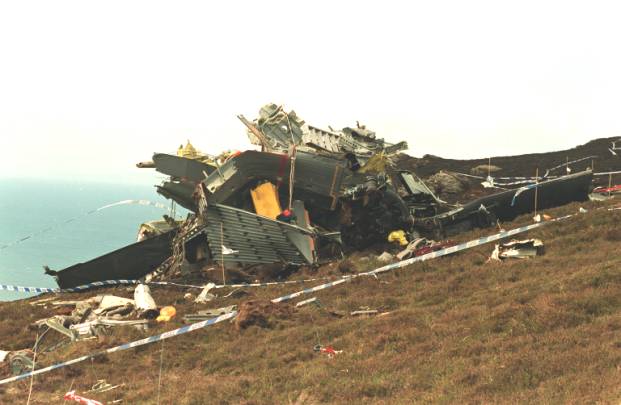The disaster was the crash of an RAF Chinook helicopter (ZD576) into the side of a mountain on the Mull of Kintyre (SW Scotland). It killed everyone on board instantly: four crew and 25 passengers, the latter all experienced counter-intelligence officers (police and military), headed for a conference at Fort George near Inverness. Their speciality was dealing with the IRA insurgency in Northern Ireland, from where they came.
I described the incident in the only book devoted entirely to this accident (Chinook Crash), published in 2004. I covered, not just the background to the flight and the crash itself, but the complicated aftermath, which included several inquiries, from a Scottish Fatal Accident Inquiry to debates and inquiries in the UK Parliament (the Scottish Parliament has never interested itself in the matter). My book also described a possible cause of the accident—namely a navigation error.
Consequently, on 26 May 2010 it was announced that Lord Philip, a retired Scottish judge would hold a private inquiry (The Mull of Kintyre Review), in which he would be assisted by three Privy Counsellors. I gave evidence to this inquiry, although its terms of reference were a mystery. It was not clear that Lord Philip was asked to find the cause of the accident, especially since neither he nor the PCs had any technical aeronautical experience.
The result of the Review was announced in the House of Commons on 13 July 2011 and it was published that same day.
As might be expected by a judge, there was no examination of the cause of the accident, only comment on the RAF rules for determining the verdict on the pilots. They had been found guilty of ‘gross negligence’ for ignoring the flight safety rules. But this verdict was based on the assumption that the RAF had ‘no doubt whatsoever’. It was quite clear that the RAF Marshals who made the determination, did have no doubt (the evidence was quite clear that the crew had ignore the rules). However, to a civil judge, no verdict could be based on ‘no doubt whatsoever’; to him all judgements were hedged about by some doubt. In civil courts verdicts are based on either ‘the balance of probabilities’ or ‘beyond reasonable doubt’.
Consequently, Lord Philip recommended that the RAF’s verdict of ‘gross negligence’ be ‘set aside’ (that’s legal jargon for parking a case and then ignoring it). That’s all he did! What an amazing deflection and avoidance of any inquiry into the cause, which he thought would never be known.
The Government seized on this opportunity to wash their hands of the matter and hastily accepted the recommendation. Unnecessarily, it also apologised to the pilots’ families and later released the compensation previously withheld from them because the pilots’ guilt.
This was generally welcomed, but with unseemly jubilation by the families, who, together with the mass media, seemed to think that the pilots were being cleared of all responsibility for the crash. In fact, there were other charges that could have been brought against the pilots, charges not based on ‘no doubt whatsoever’. But this was ignored. In any case, Lord Philip had inappropriately applied a legal nicety that still left the accident unexplained.
My several attempts to get the matter re-examined fell on deaf ears (the MoD is certainly deaf), some claiming that it would upset the families, that the cause is already known or that it will never be known.
At the time I wrote my book, there had been eight Chinook accidents, all covered by Military Aircraft Accident Summaries (I reproduced them in Appendix 1). I each case, the cause was explained. In the case of ZD576, the cause is listed as negligence by the pilots by continuing to fly towards high ground below a safe altitude, the exact cause identified by the Air Marshals. That document has not been withdrawn or amended as might be expected. So it stands uneasily as ‘guilty’ against Lord Philip’s ‘not guilty’ verdict. The MAAS concluded that it had not found any deficiencies that might have contributed to the accident and that both ADRs and CVRs would subsequently be fitted to RAF Chinooks.
While all that is unsatisfactory, even more unsatisfactory is the fact that the actual cause of the accident is not officially known, the only one of the eight cases where this is so. I find it extremely odd that the MoD has avoided any further comment and seems unwilling to re-examine their own inquiry, which they are entitled to do.
In my opinion, the pilots made a grave navigation error, which would not have mattered if they had obeyed the flight safety rules. It seems that they thought obeying the rules was optional when they were sure of their position. Unfortunately for them and their 25 passengers, they were mistaken.
So the mystery is not only why they were off-course (in fact I have explained that), but why the accident has dropped from sight. In whose interest is it that the accident is forgotten and the cause not publicly acknowledged?
